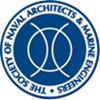碰撞停止机动中POD方位轴承的定常和非定常水动力载荷
IF 1
4区 工程技术
Q3 ENGINEERING, CIVIL
引用次数: 0
摘要
配备两个吊舱的船舶的防撞机动产生了结构和方位轴承可能承受的最大载荷。为了设计目的,足够快速和准确地确定载荷是至关重要的。本研究基于模型试验和数值方法,探讨碰撞停止机动时的载荷估计。比较力和力矩,以确定不同控制参数(方位角速率、螺旋桨转数等)的影响。此外,利用模型和全尺寸的数值模拟结果分析了雷诺数对流动特性的影响。结果表明,方位角速率对最大力和力矩有显著影响。数值计算表明,失速行为与方位角率有很强的相关性。与稳定的攻角位置相比,对外形部件(如吊舱支柱)的动态失速效应被转移到更大的攻角位置。在模型试验中也观察到这种现象。全尺寸模拟结果表明,与模型模拟结果相比,全尺寸模拟结果的作用力增加了23%。因此,需要对设计过程中考虑的结果进行详细和仔细的处理,以进行负载估计。本文章由计算机程序翻译,如有差异,请以英文原文为准。
Steady and Unsteady Hydrodynamic Loads on the Azimuth Bearing of a POD during a Crash-Stop Maneuver
The crash-stop maneuver of a ship equipped with two pods produces the largest loads that the structure and azimuth bearing can possibly experience. For design purposes, a sufficiently fast and accurate determination of the loads is thus critically important. This study examines load estimation during crash-stop maneuvers based on model tests and numerical methods. Forces and moments are compared to determine the influence of different control parameters (azimuth rate, propeller number of revolution, etc.). In addition, the results of numerical simulations carried out in model- and full-scale are used to analyze the influence of the Reynolds number on the flow behavior. Results show a significant influence of the azimuth rate on the maximum forces and moments. The numerical calculations indicate a strong dependency of the flow stall behavior on the azimuth rate. The dynamic stall effect on the profile-shaped parts, such as the pod strut, is shifted to a larger angle of attack compared with a steady angular position. This phenomenon is also observed during the model tests. The full-scale simulations show up to a 23% increase of the forces compared with the model-scale simulations. Thus, a detailed and careful handling of the results considered in the design process is required for the load estimation.
求助全文
通过发布文献求助,成功后即可免费获取论文全文。
去求助
来源期刊

Journal of Ship Research
工程技术-工程:海洋
CiteScore
2.80
自引率
0.00%
发文量
12
审稿时长
6 months
期刊介绍:
Original and Timely technical papers addressing problems of shipyard techniques and production of merchant and naval ships appear in this quarterly publication. Since its inception, the Journal of Ship Production and Design (formerly the Journal of Ship Production) has been a forum for peer-reviewed, professionally edited papers from academic and industry sources. As such, it has influenced the worldwide development of ship production engineering as a fully qualified professional discipline. The expanded scope seeks papers in additional areas, specifically ship design, including design for production, plus other marine technology topics, such as ship operations, shipping economic, and safety. Each issue contains a well-rounded selection of technical papers relevant to marine professionals.
 求助内容:
求助内容: 应助结果提醒方式:
应助结果提醒方式:


